Change Management Challenges and Strategies for Claymore Consultants
VerifiedAdded on 2022/11/17
|11
|3106
|141
Report
AI Summary
This report examines the change management issues faced by Claymore Consultants, focusing on the challenges of adapting to evolving business conditions. The report identifies key change indicators, such as issues with organizational structure, employee management, and customer retention, and analyzes the underlying causes using McKinsey's 7S framework. Internal managerial issues are highlighted as major contributors to the firm's problems. To address these challenges, the report recommends change strategies based on Lewin's change management model, emphasizing stakeholder involvement to ensure effective implementation and minimize resistance. The report concludes with a discussion of the importance of adopting a participative leadership style and customer-centric processes to improve organizational performance and long-term viability.
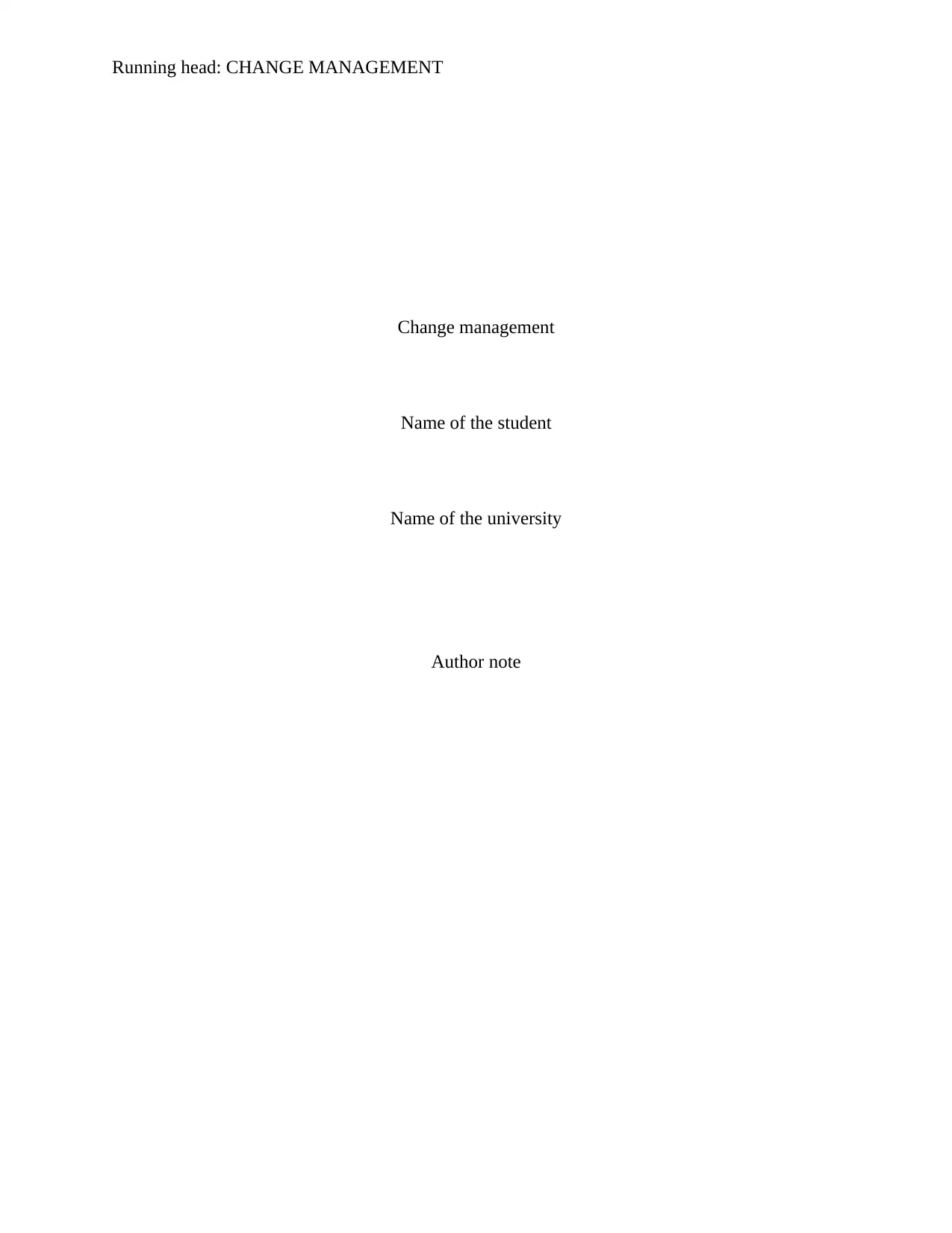
Running head: CHANGE MANAGEMENT
Change management
Name of the student
Name of the university
Author note
Change management
Name of the student
Name of the university
Author note
Paraphrase This Document
Need a fresh take? Get an instant paraphrase of this document with our AI Paraphraser
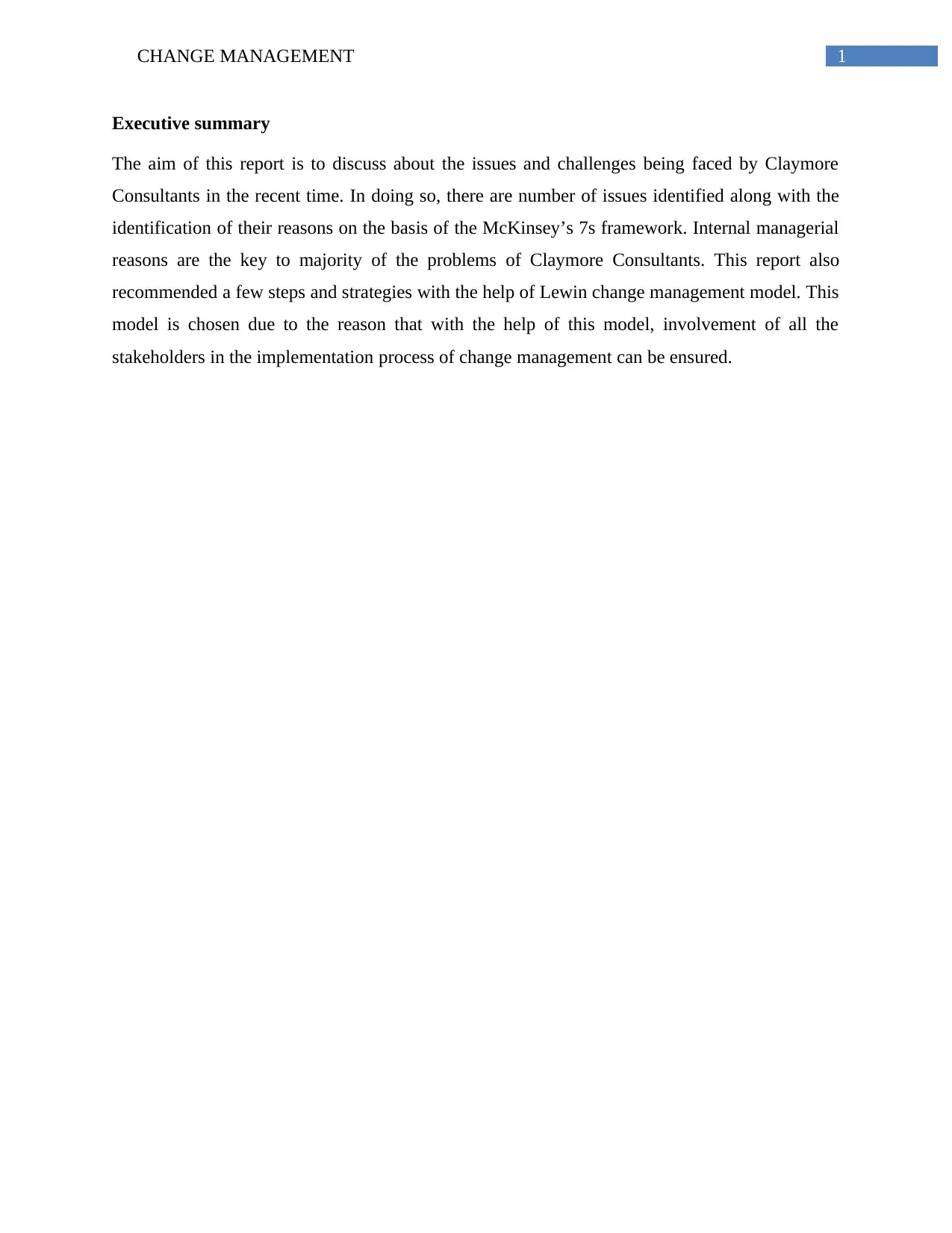
1CHANGE MANAGEMENT
Executive summary
The aim of this report is to discuss about the issues and challenges being faced by Claymore
Consultants in the recent time. In doing so, there are number of issues identified along with the
identification of their reasons on the basis of the McKinsey’s 7s framework. Internal managerial
reasons are the key to majority of the problems of Claymore Consultants. This report also
recommended a few steps and strategies with the help of Lewin change management model. This
model is chosen due to the reason that with the help of this model, involvement of all the
stakeholders in the implementation process of change management can be ensured.
Executive summary
The aim of this report is to discuss about the issues and challenges being faced by Claymore
Consultants in the recent time. In doing so, there are number of issues identified along with the
identification of their reasons on the basis of the McKinsey’s 7s framework. Internal managerial
reasons are the key to majority of the problems of Claymore Consultants. This report also
recommended a few steps and strategies with the help of Lewin change management model. This
model is chosen due to the reason that with the help of this model, involvement of all the
stakeholders in the implementation process of change management can be ensured.
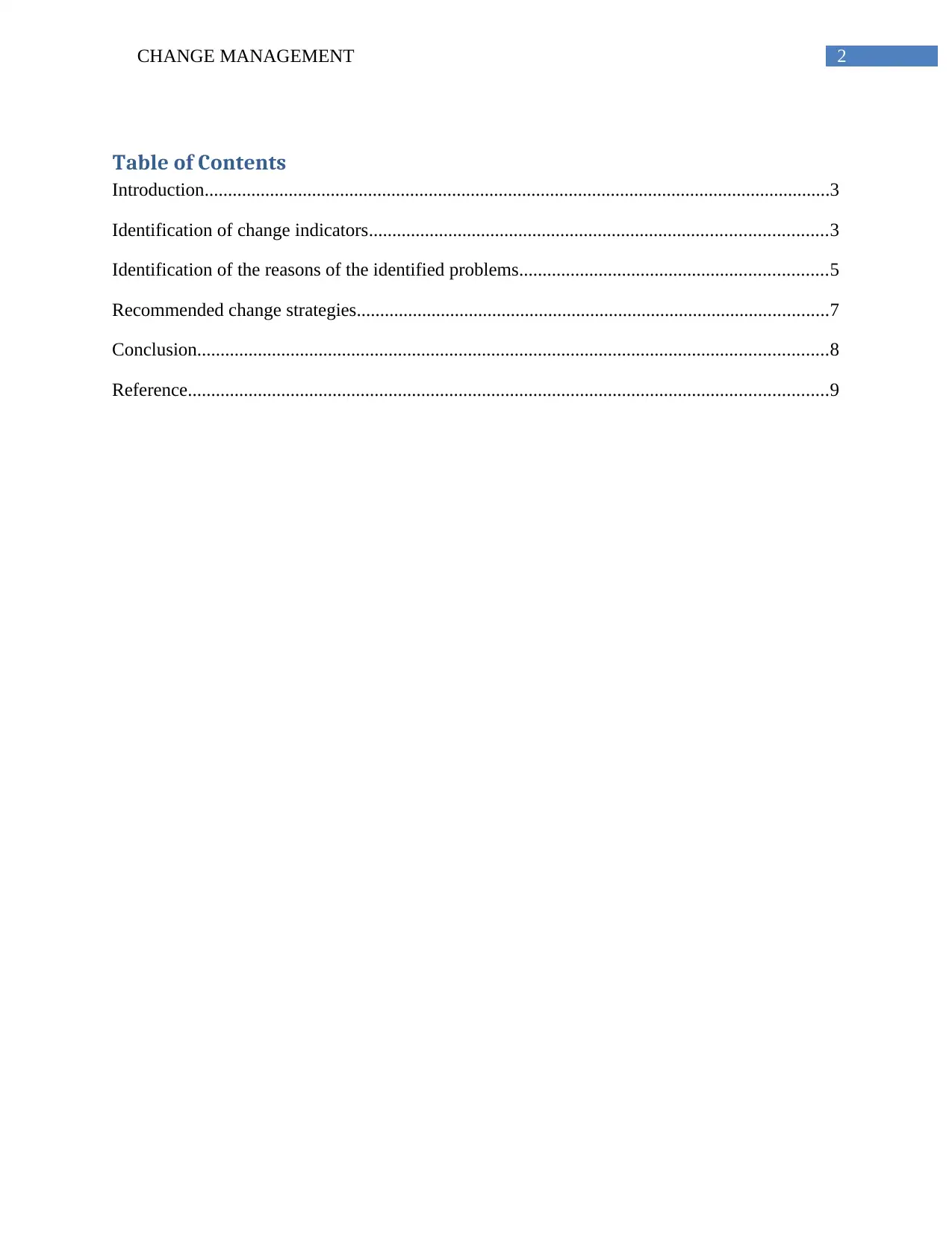
2CHANGE MANAGEMENT
Table of Contents
Introduction......................................................................................................................................3
Identification of change indicators..................................................................................................3
Identification of the reasons of the identified problems..................................................................5
Recommended change strategies.....................................................................................................7
Conclusion.......................................................................................................................................8
Reference.........................................................................................................................................9
Table of Contents
Introduction......................................................................................................................................3
Identification of change indicators..................................................................................................3
Identification of the reasons of the identified problems..................................................................5
Recommended change strategies.....................................................................................................7
Conclusion.......................................................................................................................................8
Reference.........................................................................................................................................9
⊘ This is a preview!⊘
Do you want full access?
Subscribe today to unlock all pages.

Trusted by 1+ million students worldwide
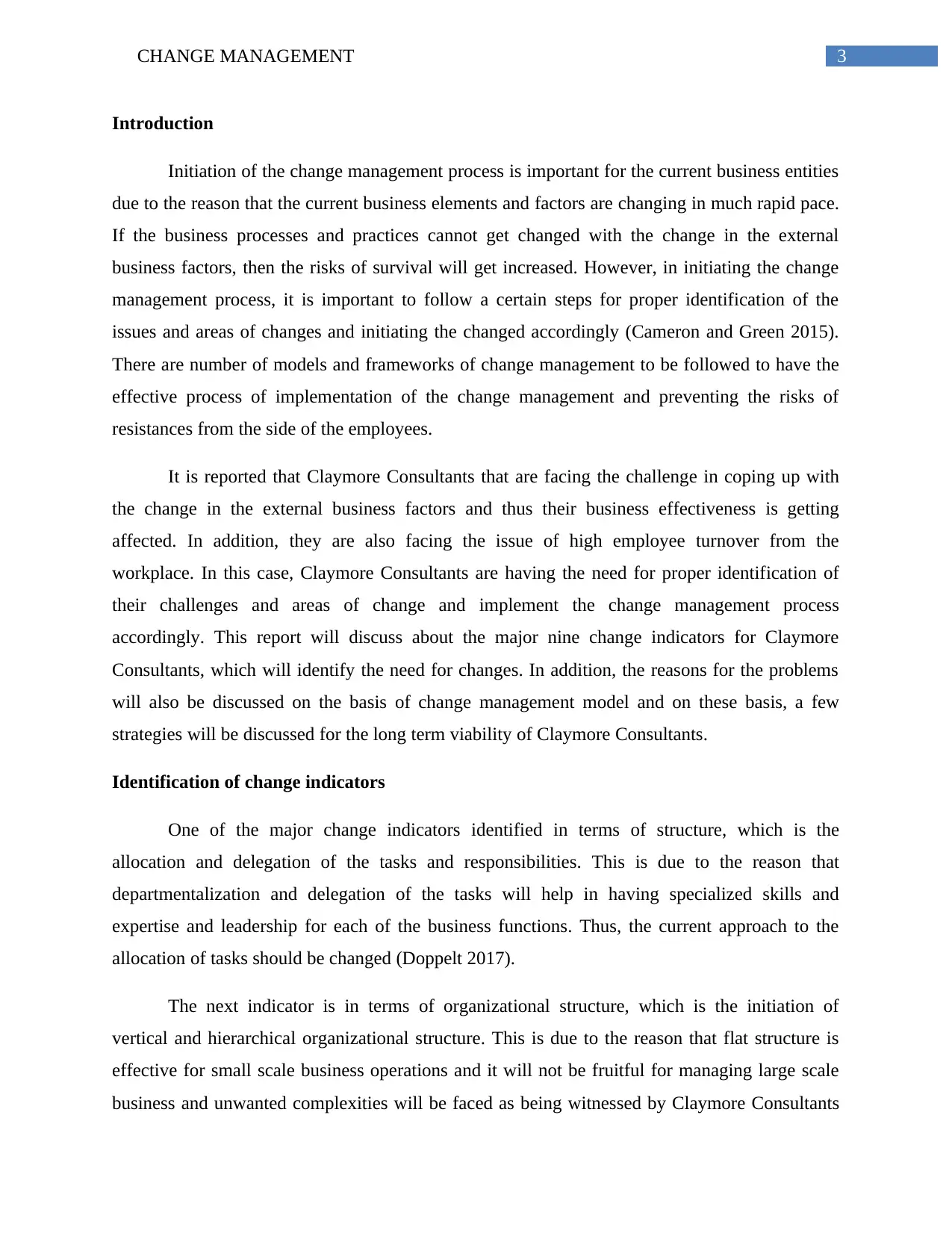
3CHANGE MANAGEMENT
Introduction
Initiation of the change management process is important for the current business entities
due to the reason that the current business elements and factors are changing in much rapid pace.
If the business processes and practices cannot get changed with the change in the external
business factors, then the risks of survival will get increased. However, in initiating the change
management process, it is important to follow a certain steps for proper identification of the
issues and areas of changes and initiating the changed accordingly (Cameron and Green 2015).
There are number of models and frameworks of change management to be followed to have the
effective process of implementation of the change management and preventing the risks of
resistances from the side of the employees.
It is reported that Claymore Consultants that are facing the challenge in coping up with
the change in the external business factors and thus their business effectiveness is getting
affected. In addition, they are also facing the issue of high employee turnover from the
workplace. In this case, Claymore Consultants are having the need for proper identification of
their challenges and areas of change and implement the change management process
accordingly. This report will discuss about the major nine change indicators for Claymore
Consultants, which will identify the need for changes. In addition, the reasons for the problems
will also be discussed on the basis of change management model and on these basis, a few
strategies will be discussed for the long term viability of Claymore Consultants.
Identification of change indicators
One of the major change indicators identified in terms of structure, which is the
allocation and delegation of the tasks and responsibilities. This is due to the reason that
departmentalization and delegation of the tasks will help in having specialized skills and
expertise and leadership for each of the business functions. Thus, the current approach to the
allocation of tasks should be changed (Doppelt 2017).
The next indicator is in terms of organizational structure, which is the initiation of
vertical and hierarchical organizational structure. This is due to the reason that flat structure is
effective for small scale business operations and it will not be fruitful for managing large scale
business and unwanted complexities will be faced as being witnessed by Claymore Consultants
Introduction
Initiation of the change management process is important for the current business entities
due to the reason that the current business elements and factors are changing in much rapid pace.
If the business processes and practices cannot get changed with the change in the external
business factors, then the risks of survival will get increased. However, in initiating the change
management process, it is important to follow a certain steps for proper identification of the
issues and areas of changes and initiating the changed accordingly (Cameron and Green 2015).
There are number of models and frameworks of change management to be followed to have the
effective process of implementation of the change management and preventing the risks of
resistances from the side of the employees.
It is reported that Claymore Consultants that are facing the challenge in coping up with
the change in the external business factors and thus their business effectiveness is getting
affected. In addition, they are also facing the issue of high employee turnover from the
workplace. In this case, Claymore Consultants are having the need for proper identification of
their challenges and areas of change and implement the change management process
accordingly. This report will discuss about the major nine change indicators for Claymore
Consultants, which will identify the need for changes. In addition, the reasons for the problems
will also be discussed on the basis of change management model and on these basis, a few
strategies will be discussed for the long term viability of Claymore Consultants.
Identification of change indicators
One of the major change indicators identified in terms of structure, which is the
allocation and delegation of the tasks and responsibilities. This is due to the reason that
departmentalization and delegation of the tasks will help in having specialized skills and
expertise and leadership for each of the business functions. Thus, the current approach to the
allocation of tasks should be changed (Doppelt 2017).
The next indicator is in terms of organizational structure, which is the initiation of
vertical and hierarchical organizational structure. This is due to the reason that flat structure is
effective for small scale business operations and it will not be fruitful for managing large scale
business and unwanted complexities will be faced as being witnessed by Claymore Consultants
Paraphrase This Document
Need a fresh take? Get an instant paraphrase of this document with our AI Paraphraser
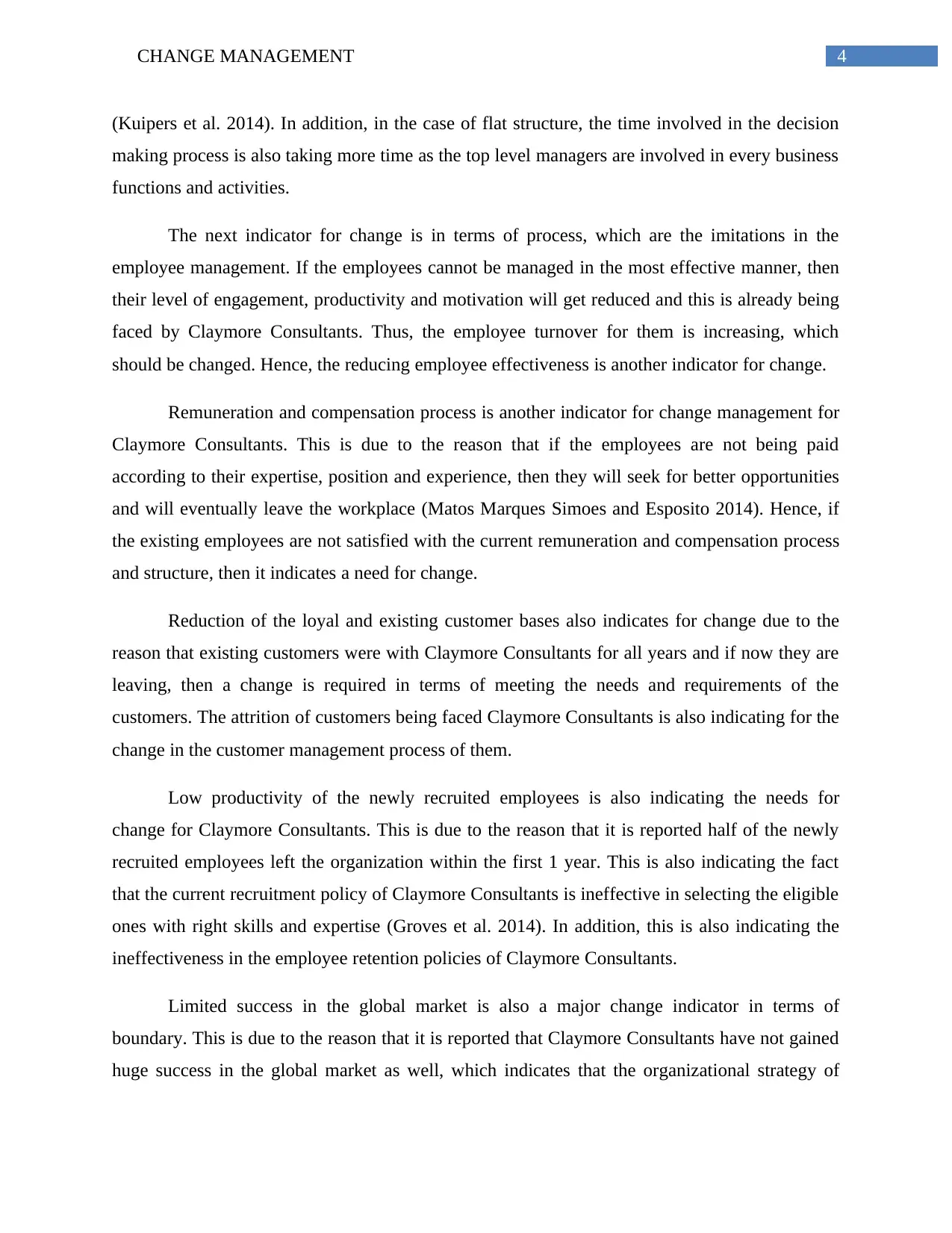
4CHANGE MANAGEMENT
(Kuipers et al. 2014). In addition, in the case of flat structure, the time involved in the decision
making process is also taking more time as the top level managers are involved in every business
functions and activities.
The next indicator for change is in terms of process, which are the imitations in the
employee management. If the employees cannot be managed in the most effective manner, then
their level of engagement, productivity and motivation will get reduced and this is already being
faced by Claymore Consultants. Thus, the employee turnover for them is increasing, which
should be changed. Hence, the reducing employee effectiveness is another indicator for change.
Remuneration and compensation process is another indicator for change management for
Claymore Consultants. This is due to the reason that if the employees are not being paid
according to their expertise, position and experience, then they will seek for better opportunities
and will eventually leave the workplace (Matos Marques Simoes and Esposito 2014). Hence, if
the existing employees are not satisfied with the current remuneration and compensation process
and structure, then it indicates a need for change.
Reduction of the loyal and existing customer bases also indicates for change due to the
reason that existing customers were with Claymore Consultants for all years and if now they are
leaving, then a change is required in terms of meeting the needs and requirements of the
customers. The attrition of customers being faced Claymore Consultants is also indicating for the
change in the customer management process of them.
Low productivity of the newly recruited employees is also indicating the needs for
change for Claymore Consultants. This is due to the reason that it is reported half of the newly
recruited employees left the organization within the first 1 year. This is also indicating the fact
that the current recruitment policy of Claymore Consultants is ineffective in selecting the eligible
ones with right skills and expertise (Groves et al. 2014). In addition, this is also indicating the
ineffectiveness in the employee retention policies of Claymore Consultants.
Limited success in the global market is also a major change indicator in terms of
boundary. This is due to the reason that it is reported that Claymore Consultants have not gained
huge success in the global market as well, which indicates that the organizational strategy of
(Kuipers et al. 2014). In addition, in the case of flat structure, the time involved in the decision
making process is also taking more time as the top level managers are involved in every business
functions and activities.
The next indicator for change is in terms of process, which are the imitations in the
employee management. If the employees cannot be managed in the most effective manner, then
their level of engagement, productivity and motivation will get reduced and this is already being
faced by Claymore Consultants. Thus, the employee turnover for them is increasing, which
should be changed. Hence, the reducing employee effectiveness is another indicator for change.
Remuneration and compensation process is another indicator for change management for
Claymore Consultants. This is due to the reason that if the employees are not being paid
according to their expertise, position and experience, then they will seek for better opportunities
and will eventually leave the workplace (Matos Marques Simoes and Esposito 2014). Hence, if
the existing employees are not satisfied with the current remuneration and compensation process
and structure, then it indicates a need for change.
Reduction of the loyal and existing customer bases also indicates for change due to the
reason that existing customers were with Claymore Consultants for all years and if now they are
leaving, then a change is required in terms of meeting the needs and requirements of the
customers. The attrition of customers being faced Claymore Consultants is also indicating for the
change in the customer management process of them.
Low productivity of the newly recruited employees is also indicating the needs for
change for Claymore Consultants. This is due to the reason that it is reported half of the newly
recruited employees left the organization within the first 1 year. This is also indicating the fact
that the current recruitment policy of Claymore Consultants is ineffective in selecting the eligible
ones with right skills and expertise (Groves et al. 2014). In addition, this is also indicating the
ineffectiveness in the employee retention policies of Claymore Consultants.
Limited success in the global market is also a major change indicator in terms of
boundary. This is due to the reason that it is reported that Claymore Consultants have not gained
huge success in the global market as well, which indicates that the organizational strategy of
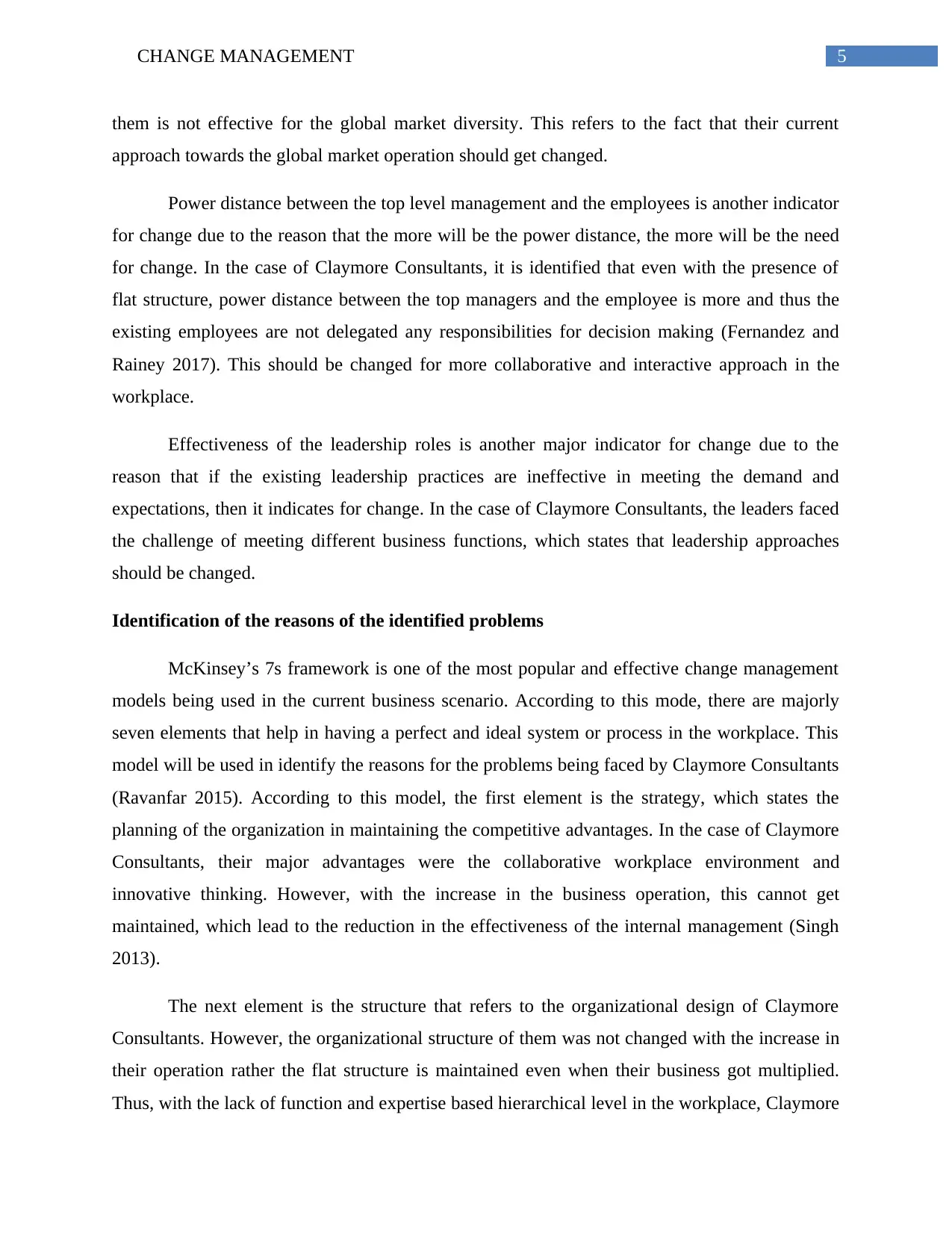
5CHANGE MANAGEMENT
them is not effective for the global market diversity. This refers to the fact that their current
approach towards the global market operation should get changed.
Power distance between the top level management and the employees is another indicator
for change due to the reason that the more will be the power distance, the more will be the need
for change. In the case of Claymore Consultants, it is identified that even with the presence of
flat structure, power distance between the top managers and the employee is more and thus the
existing employees are not delegated any responsibilities for decision making (Fernandez and
Rainey 2017). This should be changed for more collaborative and interactive approach in the
workplace.
Effectiveness of the leadership roles is another major indicator for change due to the
reason that if the existing leadership practices are ineffective in meeting the demand and
expectations, then it indicates for change. In the case of Claymore Consultants, the leaders faced
the challenge of meeting different business functions, which states that leadership approaches
should be changed.
Identification of the reasons of the identified problems
McKinsey’s 7s framework is one of the most popular and effective change management
models being used in the current business scenario. According to this mode, there are majorly
seven elements that help in having a perfect and ideal system or process in the workplace. This
model will be used in identify the reasons for the problems being faced by Claymore Consultants
(Ravanfar 2015). According to this model, the first element is the strategy, which states the
planning of the organization in maintaining the competitive advantages. In the case of Claymore
Consultants, their major advantages were the collaborative workplace environment and
innovative thinking. However, with the increase in the business operation, this cannot get
maintained, which lead to the reduction in the effectiveness of the internal management (Singh
2013).
The next element is the structure that refers to the organizational design of Claymore
Consultants. However, the organizational structure of them was not changed with the increase in
their operation rather the flat structure is maintained even when their business got multiplied.
Thus, with the lack of function and expertise based hierarchical level in the workplace, Claymore
them is not effective for the global market diversity. This refers to the fact that their current
approach towards the global market operation should get changed.
Power distance between the top level management and the employees is another indicator
for change due to the reason that the more will be the power distance, the more will be the need
for change. In the case of Claymore Consultants, it is identified that even with the presence of
flat structure, power distance between the top managers and the employee is more and thus the
existing employees are not delegated any responsibilities for decision making (Fernandez and
Rainey 2017). This should be changed for more collaborative and interactive approach in the
workplace.
Effectiveness of the leadership roles is another major indicator for change due to the
reason that if the existing leadership practices are ineffective in meeting the demand and
expectations, then it indicates for change. In the case of Claymore Consultants, the leaders faced
the challenge of meeting different business functions, which states that leadership approaches
should be changed.
Identification of the reasons of the identified problems
McKinsey’s 7s framework is one of the most popular and effective change management
models being used in the current business scenario. According to this mode, there are majorly
seven elements that help in having a perfect and ideal system or process in the workplace. This
model will be used in identify the reasons for the problems being faced by Claymore Consultants
(Ravanfar 2015). According to this model, the first element is the strategy, which states the
planning of the organization in maintaining the competitive advantages. In the case of Claymore
Consultants, their major advantages were the collaborative workplace environment and
innovative thinking. However, with the increase in the business operation, this cannot get
maintained, which lead to the reduction in the effectiveness of the internal management (Singh
2013).
The next element is the structure that refers to the organizational design of Claymore
Consultants. However, the organizational structure of them was not changed with the increase in
their operation rather the flat structure is maintained even when their business got multiplied.
Thus, with the lack of function and expertise based hierarchical level in the workplace, Claymore
⊘ This is a preview!⊘
Do you want full access?
Subscribe today to unlock all pages.

Trusted by 1+ million students worldwide
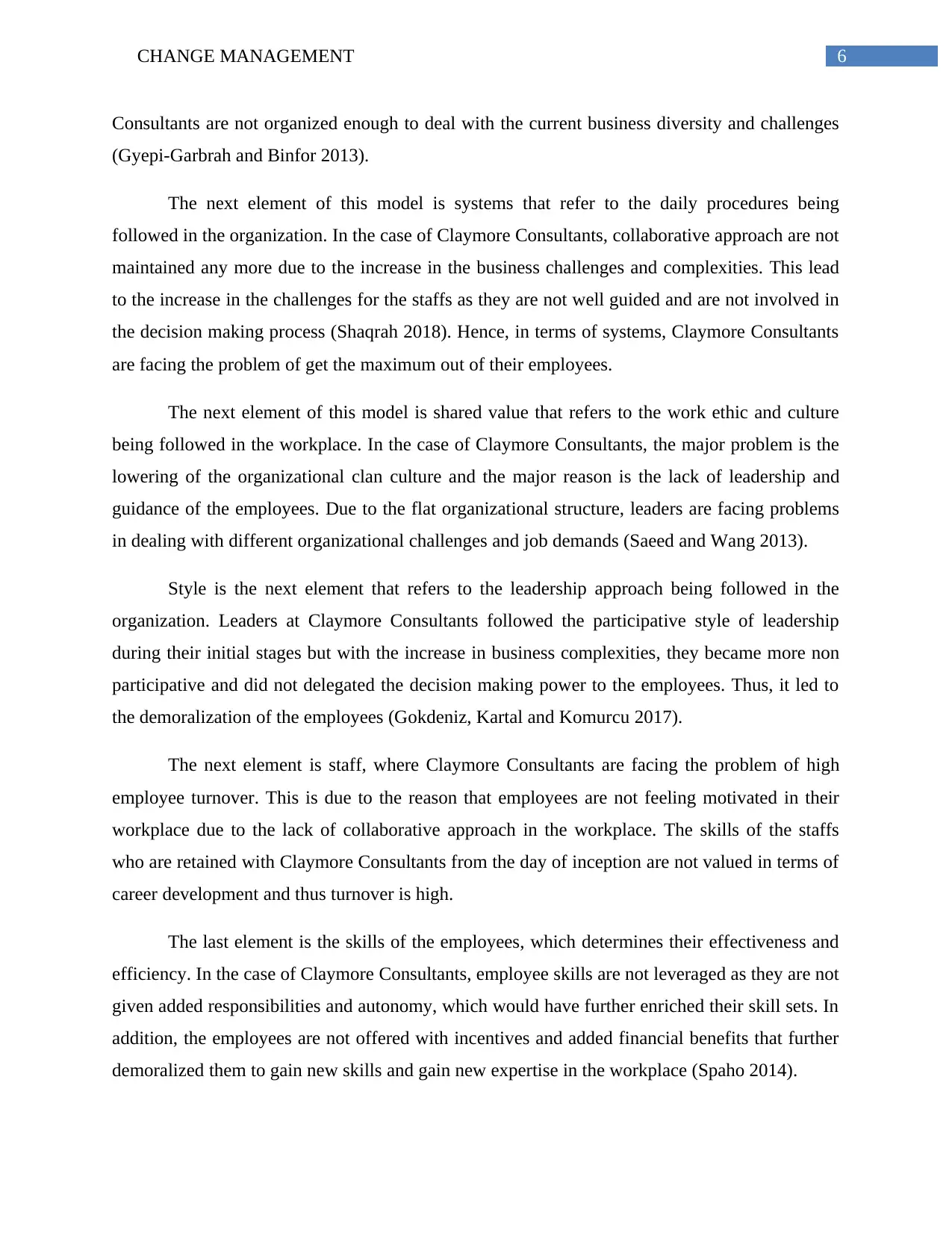
6CHANGE MANAGEMENT
Consultants are not organized enough to deal with the current business diversity and challenges
(Gyepi-Garbrah and Binfor 2013).
The next element of this model is systems that refer to the daily procedures being
followed in the organization. In the case of Claymore Consultants, collaborative approach are not
maintained any more due to the increase in the business challenges and complexities. This lead
to the increase in the challenges for the staffs as they are not well guided and are not involved in
the decision making process (Shaqrah 2018). Hence, in terms of systems, Claymore Consultants
are facing the problem of get the maximum out of their employees.
The next element of this model is shared value that refers to the work ethic and culture
being followed in the workplace. In the case of Claymore Consultants, the major problem is the
lowering of the organizational clan culture and the major reason is the lack of leadership and
guidance of the employees. Due to the flat organizational structure, leaders are facing problems
in dealing with different organizational challenges and job demands (Saeed and Wang 2013).
Style is the next element that refers to the leadership approach being followed in the
organization. Leaders at Claymore Consultants followed the participative style of leadership
during their initial stages but with the increase in business complexities, they became more non
participative and did not delegated the decision making power to the employees. Thus, it led to
the demoralization of the employees (Gokdeniz, Kartal and Komurcu 2017).
The next element is staff, where Claymore Consultants are facing the problem of high
employee turnover. This is due to the reason that employees are not feeling motivated in their
workplace due to the lack of collaborative approach in the workplace. The skills of the staffs
who are retained with Claymore Consultants from the day of inception are not valued in terms of
career development and thus turnover is high.
The last element is the skills of the employees, which determines their effectiveness and
efficiency. In the case of Claymore Consultants, employee skills are not leveraged as they are not
given added responsibilities and autonomy, which would have further enriched their skill sets. In
addition, the employees are not offered with incentives and added financial benefits that further
demoralized them to gain new skills and gain new expertise in the workplace (Spaho 2014).
Consultants are not organized enough to deal with the current business diversity and challenges
(Gyepi-Garbrah and Binfor 2013).
The next element of this model is systems that refer to the daily procedures being
followed in the organization. In the case of Claymore Consultants, collaborative approach are not
maintained any more due to the increase in the business challenges and complexities. This lead
to the increase in the challenges for the staffs as they are not well guided and are not involved in
the decision making process (Shaqrah 2018). Hence, in terms of systems, Claymore Consultants
are facing the problem of get the maximum out of their employees.
The next element of this model is shared value that refers to the work ethic and culture
being followed in the workplace. In the case of Claymore Consultants, the major problem is the
lowering of the organizational clan culture and the major reason is the lack of leadership and
guidance of the employees. Due to the flat organizational structure, leaders are facing problems
in dealing with different organizational challenges and job demands (Saeed and Wang 2013).
Style is the next element that refers to the leadership approach being followed in the
organization. Leaders at Claymore Consultants followed the participative style of leadership
during their initial stages but with the increase in business complexities, they became more non
participative and did not delegated the decision making power to the employees. Thus, it led to
the demoralization of the employees (Gokdeniz, Kartal and Komurcu 2017).
The next element is staff, where Claymore Consultants are facing the problem of high
employee turnover. This is due to the reason that employees are not feeling motivated in their
workplace due to the lack of collaborative approach in the workplace. The skills of the staffs
who are retained with Claymore Consultants from the day of inception are not valued in terms of
career development and thus turnover is high.
The last element is the skills of the employees, which determines their effectiveness and
efficiency. In the case of Claymore Consultants, employee skills are not leveraged as they are not
given added responsibilities and autonomy, which would have further enriched their skill sets. In
addition, the employees are not offered with incentives and added financial benefits that further
demoralized them to gain new skills and gain new expertise in the workplace (Spaho 2014).
Paraphrase This Document
Need a fresh take? Get an instant paraphrase of this document with our AI Paraphraser
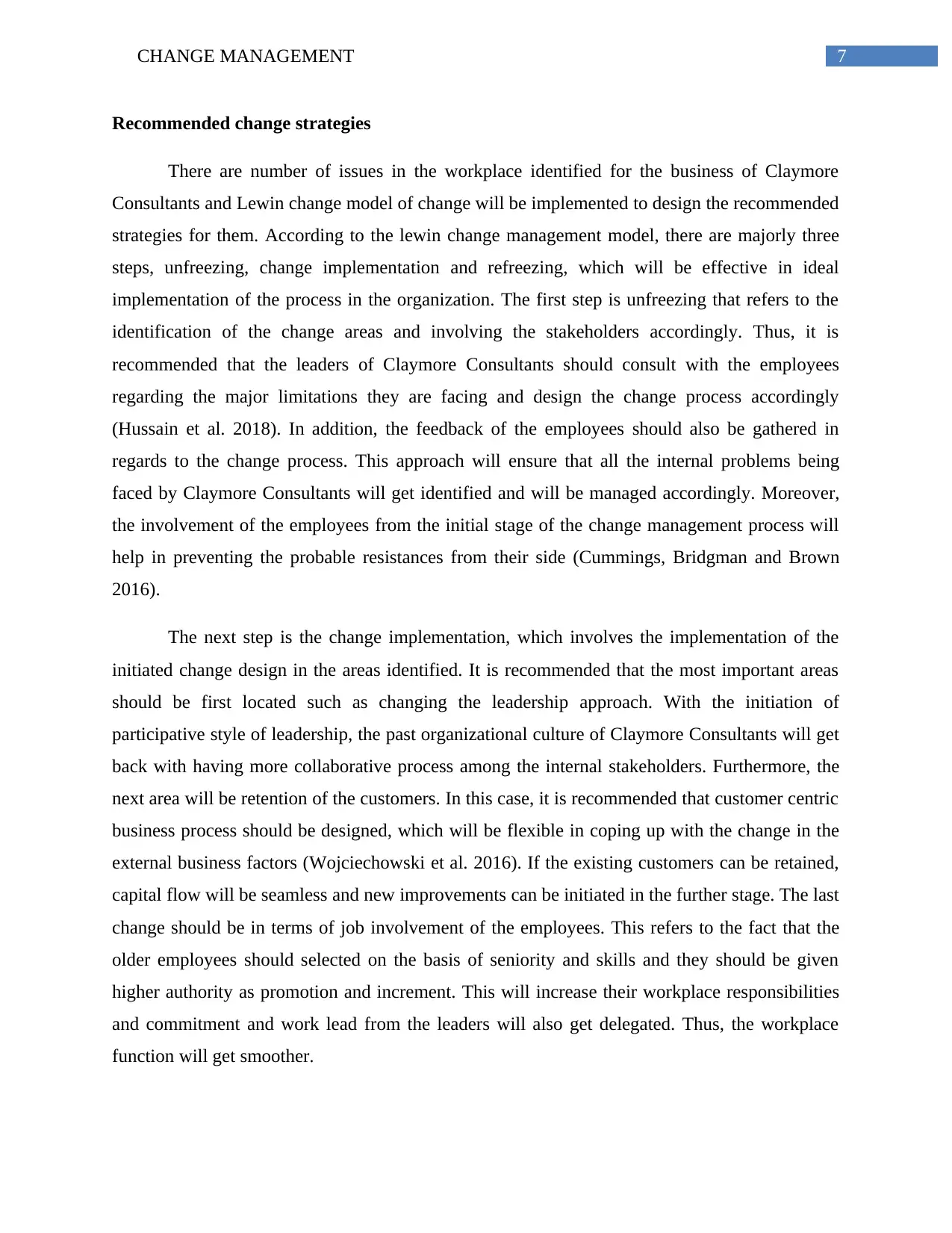
7CHANGE MANAGEMENT
Recommended change strategies
There are number of issues in the workplace identified for the business of Claymore
Consultants and Lewin change model of change will be implemented to design the recommended
strategies for them. According to the lewin change management model, there are majorly three
steps, unfreezing, change implementation and refreezing, which will be effective in ideal
implementation of the process in the organization. The first step is unfreezing that refers to the
identification of the change areas and involving the stakeholders accordingly. Thus, it is
recommended that the leaders of Claymore Consultants should consult with the employees
regarding the major limitations they are facing and design the change process accordingly
(Hussain et al. 2018). In addition, the feedback of the employees should also be gathered in
regards to the change process. This approach will ensure that all the internal problems being
faced by Claymore Consultants will get identified and will be managed accordingly. Moreover,
the involvement of the employees from the initial stage of the change management process will
help in preventing the probable resistances from their side (Cummings, Bridgman and Brown
2016).
The next step is the change implementation, which involves the implementation of the
initiated change design in the areas identified. It is recommended that the most important areas
should be first located such as changing the leadership approach. With the initiation of
participative style of leadership, the past organizational culture of Claymore Consultants will get
back with having more collaborative process among the internal stakeholders. Furthermore, the
next area will be retention of the customers. In this case, it is recommended that customer centric
business process should be designed, which will be flexible in coping up with the change in the
external business factors (Wojciechowski et al. 2016). If the existing customers can be retained,
capital flow will be seamless and new improvements can be initiated in the further stage. The last
change should be in terms of job involvement of the employees. This refers to the fact that the
older employees should selected on the basis of seniority and skills and they should be given
higher authority as promotion and increment. This will increase their workplace responsibilities
and commitment and work lead from the leaders will also get delegated. Thus, the workplace
function will get smoother.
Recommended change strategies
There are number of issues in the workplace identified for the business of Claymore
Consultants and Lewin change model of change will be implemented to design the recommended
strategies for them. According to the lewin change management model, there are majorly three
steps, unfreezing, change implementation and refreezing, which will be effective in ideal
implementation of the process in the organization. The first step is unfreezing that refers to the
identification of the change areas and involving the stakeholders accordingly. Thus, it is
recommended that the leaders of Claymore Consultants should consult with the employees
regarding the major limitations they are facing and design the change process accordingly
(Hussain et al. 2018). In addition, the feedback of the employees should also be gathered in
regards to the change process. This approach will ensure that all the internal problems being
faced by Claymore Consultants will get identified and will be managed accordingly. Moreover,
the involvement of the employees from the initial stage of the change management process will
help in preventing the probable resistances from their side (Cummings, Bridgman and Brown
2016).
The next step is the change implementation, which involves the implementation of the
initiated change design in the areas identified. It is recommended that the most important areas
should be first located such as changing the leadership approach. With the initiation of
participative style of leadership, the past organizational culture of Claymore Consultants will get
back with having more collaborative process among the internal stakeholders. Furthermore, the
next area will be retention of the customers. In this case, it is recommended that customer centric
business process should be designed, which will be flexible in coping up with the change in the
external business factors (Wojciechowski et al. 2016). If the existing customers can be retained,
capital flow will be seamless and new improvements can be initiated in the further stage. The last
change should be in terms of job involvement of the employees. This refers to the fact that the
older employees should selected on the basis of seniority and skills and they should be given
higher authority as promotion and increment. This will increase their workplace responsibilities
and commitment and work lead from the leaders will also get delegated. Thus, the workplace
function will get smoother.
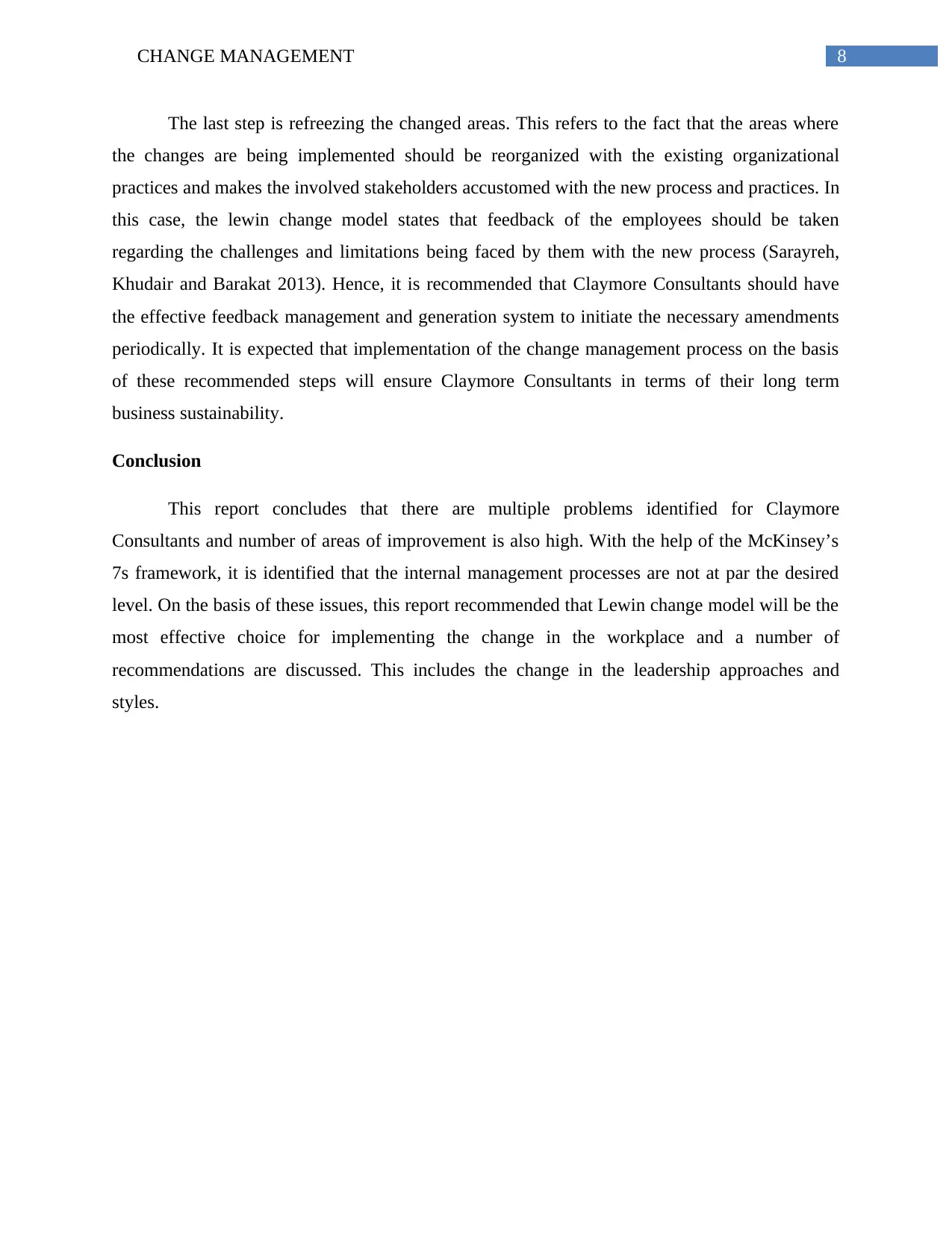
8CHANGE MANAGEMENT
The last step is refreezing the changed areas. This refers to the fact that the areas where
the changes are being implemented should be reorganized with the existing organizational
practices and makes the involved stakeholders accustomed with the new process and practices. In
this case, the lewin change model states that feedback of the employees should be taken
regarding the challenges and limitations being faced by them with the new process (Sarayreh,
Khudair and Barakat 2013). Hence, it is recommended that Claymore Consultants should have
the effective feedback management and generation system to initiate the necessary amendments
periodically. It is expected that implementation of the change management process on the basis
of these recommended steps will ensure Claymore Consultants in terms of their long term
business sustainability.
Conclusion
This report concludes that there are multiple problems identified for Claymore
Consultants and number of areas of improvement is also high. With the help of the McKinsey’s
7s framework, it is identified that the internal management processes are not at par the desired
level. On the basis of these issues, this report recommended that Lewin change model will be the
most effective choice for implementing the change in the workplace and a number of
recommendations are discussed. This includes the change in the leadership approaches and
styles.
The last step is refreezing the changed areas. This refers to the fact that the areas where
the changes are being implemented should be reorganized with the existing organizational
practices and makes the involved stakeholders accustomed with the new process and practices. In
this case, the lewin change model states that feedback of the employees should be taken
regarding the challenges and limitations being faced by them with the new process (Sarayreh,
Khudair and Barakat 2013). Hence, it is recommended that Claymore Consultants should have
the effective feedback management and generation system to initiate the necessary amendments
periodically. It is expected that implementation of the change management process on the basis
of these recommended steps will ensure Claymore Consultants in terms of their long term
business sustainability.
Conclusion
This report concludes that there are multiple problems identified for Claymore
Consultants and number of areas of improvement is also high. With the help of the McKinsey’s
7s framework, it is identified that the internal management processes are not at par the desired
level. On the basis of these issues, this report recommended that Lewin change model will be the
most effective choice for implementing the change in the workplace and a number of
recommendations are discussed. This includes the change in the leadership approaches and
styles.
⊘ This is a preview!⊘
Do you want full access?
Subscribe today to unlock all pages.

Trusted by 1+ million students worldwide
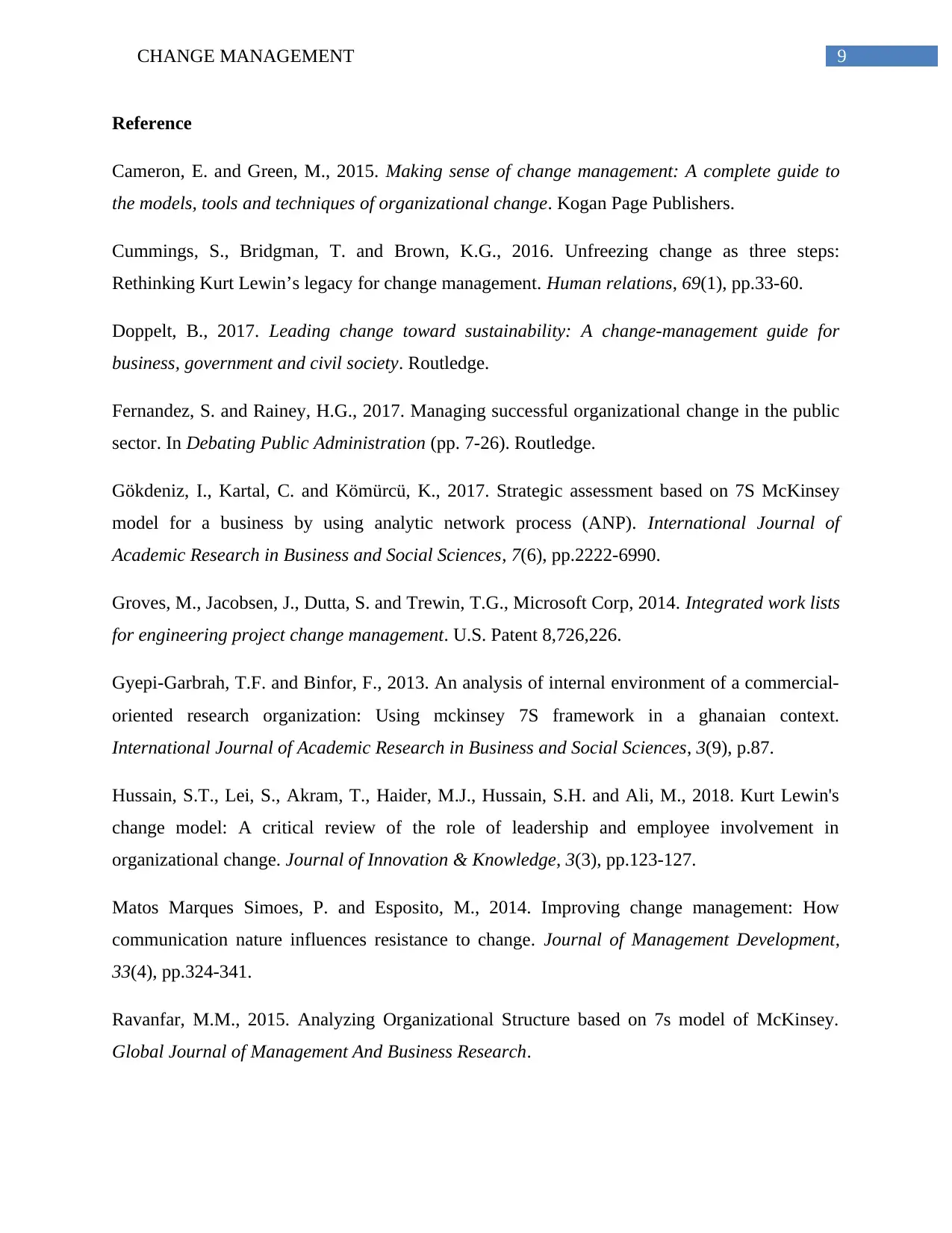
9CHANGE MANAGEMENT
Reference
Cameron, E. and Green, M., 2015. Making sense of change management: A complete guide to
the models, tools and techniques of organizational change. Kogan Page Publishers.
Cummings, S., Bridgman, T. and Brown, K.G., 2016. Unfreezing change as three steps:
Rethinking Kurt Lewin’s legacy for change management. Human relations, 69(1), pp.33-60.
Doppelt, B., 2017. Leading change toward sustainability: A change-management guide for
business, government and civil society. Routledge.
Fernandez, S. and Rainey, H.G., 2017. Managing successful organizational change in the public
sector. In Debating Public Administration (pp. 7-26). Routledge.
Gökdeniz, I., Kartal, C. and Kömürcü, K., 2017. Strategic assessment based on 7S McKinsey
model for a business by using analytic network process (ANP). International Journal of
Academic Research in Business and Social Sciences, 7(6), pp.2222-6990.
Groves, M., Jacobsen, J., Dutta, S. and Trewin, T.G., Microsoft Corp, 2014. Integrated work lists
for engineering project change management. U.S. Patent 8,726,226.
Gyepi-Garbrah, T.F. and Binfor, F., 2013. An analysis of internal environment of a commercial-
oriented research organization: Using mckinsey 7S framework in a ghanaian context.
International Journal of Academic Research in Business and Social Sciences, 3(9), p.87.
Hussain, S.T., Lei, S., Akram, T., Haider, M.J., Hussain, S.H. and Ali, M., 2018. Kurt Lewin's
change model: A critical review of the role of leadership and employee involvement in
organizational change. Journal of Innovation & Knowledge, 3(3), pp.123-127.
Matos Marques Simoes, P. and Esposito, M., 2014. Improving change management: How
communication nature influences resistance to change. Journal of Management Development,
33(4), pp.324-341.
Ravanfar, M.M., 2015. Analyzing Organizational Structure based on 7s model of McKinsey.
Global Journal of Management And Business Research.
Reference
Cameron, E. and Green, M., 2015. Making sense of change management: A complete guide to
the models, tools and techniques of organizational change. Kogan Page Publishers.
Cummings, S., Bridgman, T. and Brown, K.G., 2016. Unfreezing change as three steps:
Rethinking Kurt Lewin’s legacy for change management. Human relations, 69(1), pp.33-60.
Doppelt, B., 2017. Leading change toward sustainability: A change-management guide for
business, government and civil society. Routledge.
Fernandez, S. and Rainey, H.G., 2017. Managing successful organizational change in the public
sector. In Debating Public Administration (pp. 7-26). Routledge.
Gökdeniz, I., Kartal, C. and Kömürcü, K., 2017. Strategic assessment based on 7S McKinsey
model for a business by using analytic network process (ANP). International Journal of
Academic Research in Business and Social Sciences, 7(6), pp.2222-6990.
Groves, M., Jacobsen, J., Dutta, S. and Trewin, T.G., Microsoft Corp, 2014. Integrated work lists
for engineering project change management. U.S. Patent 8,726,226.
Gyepi-Garbrah, T.F. and Binfor, F., 2013. An analysis of internal environment of a commercial-
oriented research organization: Using mckinsey 7S framework in a ghanaian context.
International Journal of Academic Research in Business and Social Sciences, 3(9), p.87.
Hussain, S.T., Lei, S., Akram, T., Haider, M.J., Hussain, S.H. and Ali, M., 2018. Kurt Lewin's
change model: A critical review of the role of leadership and employee involvement in
organizational change. Journal of Innovation & Knowledge, 3(3), pp.123-127.
Matos Marques Simoes, P. and Esposito, M., 2014. Improving change management: How
communication nature influences resistance to change. Journal of Management Development,
33(4), pp.324-341.
Ravanfar, M.M., 2015. Analyzing Organizational Structure based on 7s model of McKinsey.
Global Journal of Management And Business Research.
Paraphrase This Document
Need a fresh take? Get an instant paraphrase of this document with our AI Paraphraser
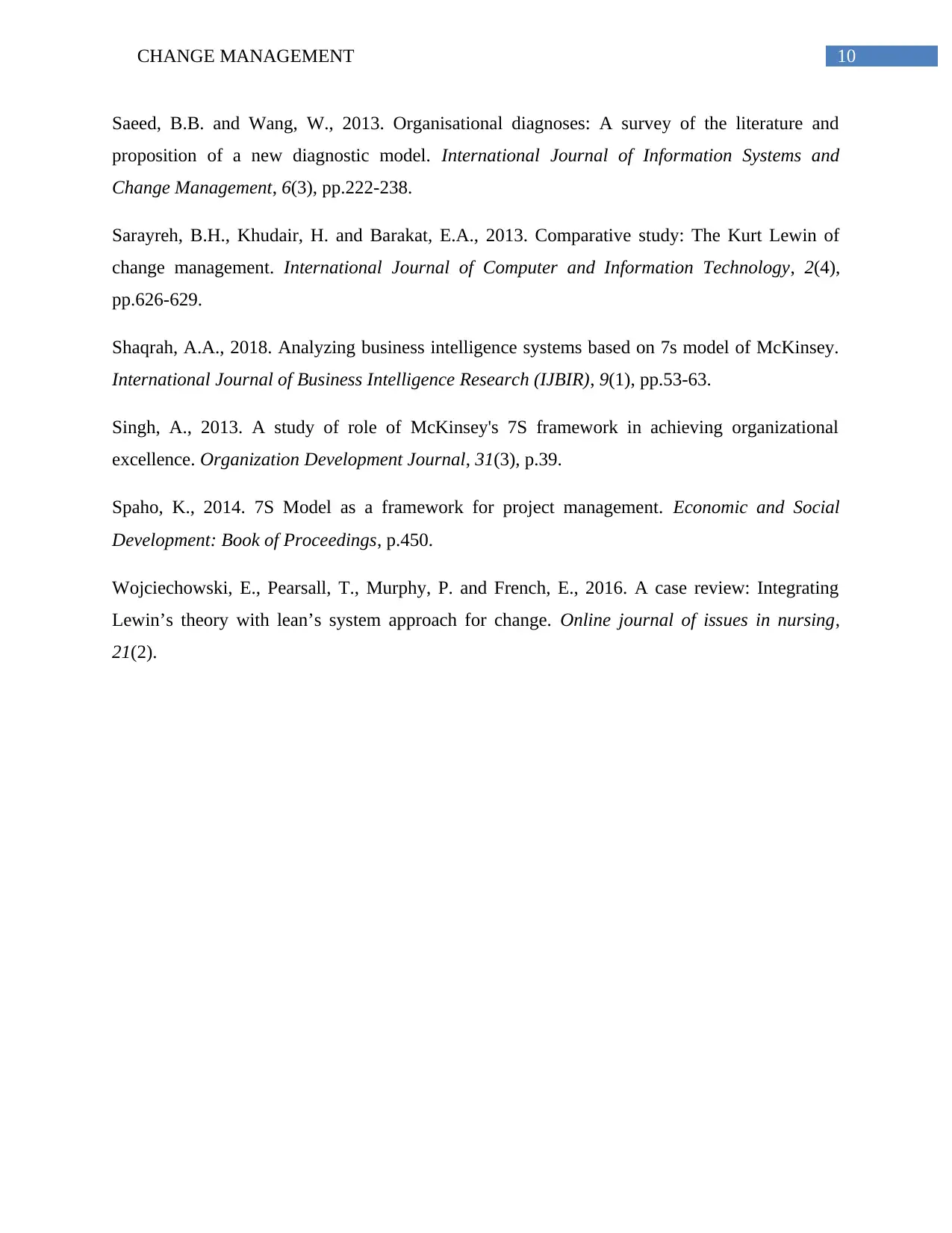
10CHANGE MANAGEMENT
Saeed, B.B. and Wang, W., 2013. Organisational diagnoses: A survey of the literature and
proposition of a new diagnostic model. International Journal of Information Systems and
Change Management, 6(3), pp.222-238.
Sarayreh, B.H., Khudair, H. and Barakat, E.A., 2013. Comparative study: The Kurt Lewin of
change management. International Journal of Computer and Information Technology, 2(4),
pp.626-629.
Shaqrah, A.A., 2018. Analyzing business intelligence systems based on 7s model of McKinsey.
International Journal of Business Intelligence Research (IJBIR), 9(1), pp.53-63.
Singh, A., 2013. A study of role of McKinsey's 7S framework in achieving organizational
excellence. Organization Development Journal, 31(3), p.39.
Spaho, K., 2014. 7S Model as a framework for project management. Economic and Social
Development: Book of Proceedings, p.450.
Wojciechowski, E., Pearsall, T., Murphy, P. and French, E., 2016. A case review: Integrating
Lewin’s theory with lean’s system approach for change. Online journal of issues in nursing,
21(2).
Saeed, B.B. and Wang, W., 2013. Organisational diagnoses: A survey of the literature and
proposition of a new diagnostic model. International Journal of Information Systems and
Change Management, 6(3), pp.222-238.
Sarayreh, B.H., Khudair, H. and Barakat, E.A., 2013. Comparative study: The Kurt Lewin of
change management. International Journal of Computer and Information Technology, 2(4),
pp.626-629.
Shaqrah, A.A., 2018. Analyzing business intelligence systems based on 7s model of McKinsey.
International Journal of Business Intelligence Research (IJBIR), 9(1), pp.53-63.
Singh, A., 2013. A study of role of McKinsey's 7S framework in achieving organizational
excellence. Organization Development Journal, 31(3), p.39.
Spaho, K., 2014. 7S Model as a framework for project management. Economic and Social
Development: Book of Proceedings, p.450.
Wojciechowski, E., Pearsall, T., Murphy, P. and French, E., 2016. A case review: Integrating
Lewin’s theory with lean’s system approach for change. Online journal of issues in nursing,
21(2).
1 out of 11
Related Documents
Your All-in-One AI-Powered Toolkit for Academic Success.
+13062052269
info@desklib.com
Available 24*7 on WhatsApp / Email
![[object Object]](/_next/static/media/star-bottom.7253800d.svg)
Unlock your academic potential
Copyright © 2020–2025 A2Z Services. All Rights Reserved. Developed and managed by ZUCOL.




